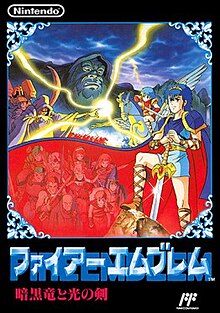Fire Emblem: Shadow Dragon and the Blade of Light
This article needs additional citations for verification. (June 2007) |
| Fire Emblem: Shadow Dragon and the Blade of Light[1] | |
|---|---|
 | |
| Developer(s) | Nintendo R&D1 Intelligent Systems |
| Publisher(s) | Nintendo |
| Director(s) | Keisuke Terasaki |
| Producer(s) | Gunpei Yokoi |
| Designer(s) | Shouzou Kaga |
| Artist(s) | Tohru Ohsawa Naotaka Ohnishi Saotshi Machida Toshitaka Muramatsu |
| Writer(s) | Shouzou Kaga |
| Composer(s) | Yuka Tsujiyoko |
| Series | Fire Emblem |
| Platform(s) | Famicom |
| Genre(s) | Tactical role-playing game |
| Mode(s) | Single-player |
Fire Emblem: Shadow Dragon and the Blade of Light[2][3] (ファイアーエムブレム 暗黒竜と光の剣, Faiā Emuburemu: Ankoku Ryū to Hikari no Tsurugi),[4] sometimes called Fire Emblem, is a 1990 tactical role-playing game developed by Nintendo R&D1 and published by Nintendo for the Family Computer, and the first game in the long-running Fire Emblem series.
Fire Emblem was one of the earliest series in the turn-based strategy genre on home consoles. However, unlike other strategy games, it borrowed several elements from role-playing video games such as Dragon Quest, and is among the first games, if not the first, in the tactical role-playing game genre. Later games in the series made numerous changes to the gameplay.
The game stars Marth, a character who later became better known outside of Japan for his appearance in the Super Smash Bros. series.
Gameplay
Characters are each unique, in terms of both class and stats, and a character who runs out of hit points usually remains dead. The game is turn-based tactics game, with different sides alternately moving and attacking with their characters. Strategy arises in placing different characters with different strengths or weaknesses in key positions, or attacking opponents with characters that have a bonus towards attacking enemies with specific traits. Over time characters develop and level up, often causing increases in skills and stats characteristic to their class.
Plot
Setting
The game takes place on the fictional continent of Akaneia (Archanea in the North American localization). The third game in the series, Fire Emblem: Mystery of the Emblem as well as their respective remakes: Fire Emblem: Shadow Dragon, and Fire Emblem: New Mystery of the Emblem, also take place in Akaneia. The thirteenth game, Fire Emblem: Awakening takes place on the continents of both Akaneia and Valentia, the continent of Fire Emblem Gaiden. The Akaneia Series, as it's known to fans, is the most frequently visited setting of Fire Emblem, with a total of four original games and two remakes.
Story
After an attack from the neighboring kingdom of Dolhr, prince Marth of Altea is forced to become an exile in the neighboring nation of Talys. His sister Ellis is taken hostage after his father is killed battling the evil priest Gharnef. With the help of the Altean knight Jagen, the Talysian Princess Caeda, and others, Marth embarks on a quest to find the sacred sword known as Falchion (the same blade wielded by Marth's ancestor, Anri) and the Fire Emblem; A sacred shield that will allow him to wield Falchion. Only then will he be able to confront Gharnef and the resurrected Medeus, liberate the kingdoms of Archanea, and rescue his sister.
Development
Development of Fire Emblem began after developer Intelligent Systems diverted its focus from creating hardware for the NES and Famicom Disk System to developing simulation games. After completing development of Famicom Wars, the team wanted to make a simulation game that used role-playing elements, leading to Fire Emblem. Initially, the development team was not very large, and the staff did a variety of tasks outside of the tasks assigned to them. Due to Fire Emblem using more memory than the FC could handle, the team had to go around this by using a portion of the FC's memory devoted to saving the game.[5]
Versions and re-releases
The game was remade for the Super Famicom as Fire Emblem: Mystery of the Emblem, which also contains a new scenario that serves as a sequel to the original game. A second remake entitled Fire Emblem: Shadow Dragon has been made for the Nintendo DS handheld.
Reception
Sales of the game were flat for the first two months of sales, but improved after word of mouth had spread.[5]
References
- ^ "Fire Emblem: Shadow Dragon". Nintendo.fi (in Finnish). Nintendo. Archived from the original on November 19, 2013. Retrieved 19 November 2013.
- ^ "Fire Emblem: Shadow Dragon Set for EU Release on December 5 - News".
- ^ "Nintendo of Europe".
- ^ The game itself simply uses the "ファイアーエムブレム"/"FIRE EMBLEM" part of the logo and does not mention the subtitle.
- ^ a b "Iwata Asks - Fire Emblem: Shadow Dragon". 4 November 2010. Archived from the original on November 4, 2010.
{{cite web}}: Unknown parameter|deadurl=ignored (|url-status=suggested) (help)
